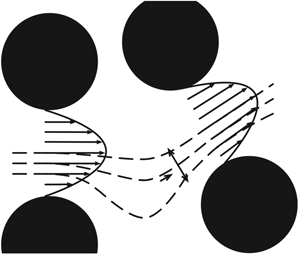Article contents
The diffusing-velocity random walk: a spatial-Markov formulation of heterogeneous advection and diffusion
Published online by Cambridge University Press: 08 January 2021
Abstract

The spatial distribution of a scalar undergoing advection and diffusion is impacted by the velocity variability sampled by tracer particles. In spatially structured velocity fields, such as porous medium flows, Lagrangian velocities along streamlines are often characterized by a well-defined correlation length and can thus be described by spatial-Markov processes. Diffusion, on the other hand, is generally modelled as a temporal process, making it challenging to capture advective and diffusive dynamics in a single framework. We develop a description of transport based on a spatial-Markov velocity process along Lagrangian particle trajectories, incorporating the effect of diffusion as a local averaging process in velocity space. The impact of flow structure on this diffusive averaging is quantified through an effective shear rate. The latter is fully determined by the point statistics of velocity magnitudes together with characteristic longitudinal and transverse length scales associated with the flow field. For infinite longitudinal correlation length, our framework recovers Taylor dispersion, and in the absence of diffusion it reduces to a standard spatial-Markov velocity model. We derive dynamical equations governing the evolution of particle position and velocity and obtain scaling laws for the dependence of longitudinal dispersion on Péclet number. These results provide new insights into the role of shear and diffusion on dispersion processes in heterogeneous media.
JFM classification
Information
- Type
- JFM Papers
- Information
- Copyright
- © The Author(s), 2021. Published by Cambridge University Press
References
REFERENCES
- 12
- Cited by


